“Our perception of sheep is so different to the reality of the sheep. We see sheep as woolly animals. To get through that woolliness to the essence of the sheep is very hard. But it is important to remember that sheep are incredibly powerful animals in their own way” - Andy Goldsworthy
Summary
Felt-making is one of the ancient crafts, in which we bring together light and flimsy wool fibres, and make strong, beautiful and robust felt that in historic times was used for clothes, rugs, hats and even waterproof building materials. In the spring you can find lots of wool in the fields and clinging to fences. It is an excellent time to go on a treasure hunt, following the trail of wool hooked on barbed wire or prickly bushes. When you look at wool under a microscope, you see it has tiny barbs on it so when it is rubbed and rolled with soap and hot water, these barbs or scales are lifted and snagged and get knotted up together creating felt. With continued rolling with strong hand pressure the felt becomes smoother: more condensed and compacted. Students are filled with a sense of wonder and excitement as they create and shape a piece of art work from wool. The piece of art changes and evolves through the different stages of felt making, transitioning from a collection of layers of loose fibres to strong decorative fabric. Isobel provides a fantastic work sheet showing the entire process of felt-making, which people attending the course can take home for re-use later.
Sheep have an important relationship with the many places in our landscape. Their grazing helps create the way it looks. They feed off the new shoots in spring and they produce some of the first new animal life – lambs: the ultimate sign of spring.
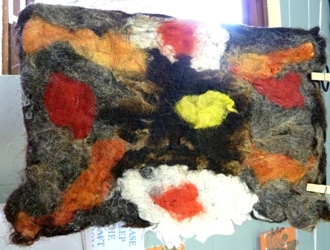 |
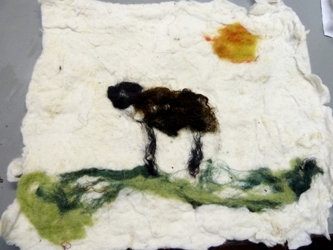 |
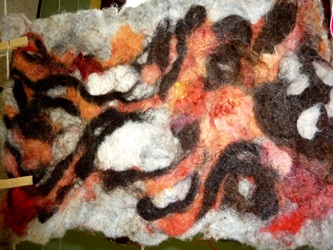 |
To celebrate this powerful “Being” we can collect the light and flimsy wool and make strong, beautiful and robust felt. Felting is an ancient craft over 5000 years old. Felt can be soft enough to make slippers or hard enough to build a house. Yurts are made from felt in Mongolia; the lanolin in the wool keeps the house waterproof and the wool keeps it warm. In the spring you can find lots of wool in the fields and clinging to fences. It is an excellent time to go on a treasure hunt, following the trail of wool hooked on barbed wire or prickly bushes.
“Felt is organic and humble and primal, yet ethereal and beautiful and sensuous. It is warm and soft and yielding, yet strong and hard and dense.” - Hand felted jewellery and beads, by Carol Huber Cypher
I laid out before the students different kinds of wool: Swaledale, Jacob, Herdwick, and some dyed colourful wool. They were excited to see the different colours and types of wool and noticed how different the colours of wool could be that was just straight from the sheep with no processing! They were also interested to see what was caught up in the wool. Soil, leaves, sticks, seeds: stories of where the sheep had been on travels. When you look at wool under a microscope you see it has tiny barbs on it so when it is rubbed and rolled with soap and hot water, these barbs or scales are lifted and snagged and get knotted up together creating felt. With continued rolling with strong hand pressure the felt becomes smoother and more condensed and compacted.
To contain the wool while making felt art wall hangings, wrap the work in a piece of old sheet of suitable size to wrap round both sides of the work and fit in your sink or bowl. Gently pull ‘drafts’ of wool from the fleece, the fibres are about two to three inches long. Arrange the fibres all pointing in one direction on the top layer of the folded piece of sheeting. Fill up the whole area with a thin sheet of fibres make sure there are no gaps. When the whole area is covered, lay the fibres out in the opposite direction to the first layer. Continue like this for three to four layers changing the direction of the wool fibre each time. This mesh of wool fibres will make a strong fabric when felted and forms the under layer of the hanging.
The final layer of the wool fibres will be the background colour of your design, with areas of coloured wool fibres creating the pattern or picture. To help the design stay in place during felting, sew it loosely with big stitches into the mesh of wool fibres.
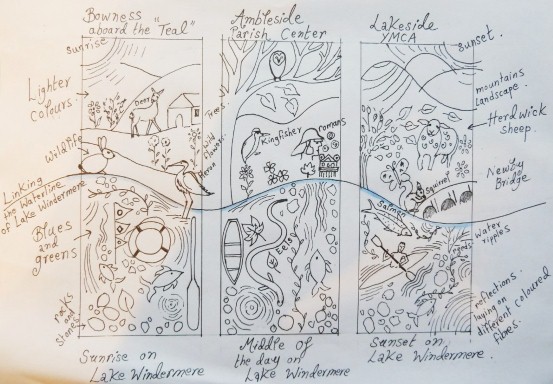 |
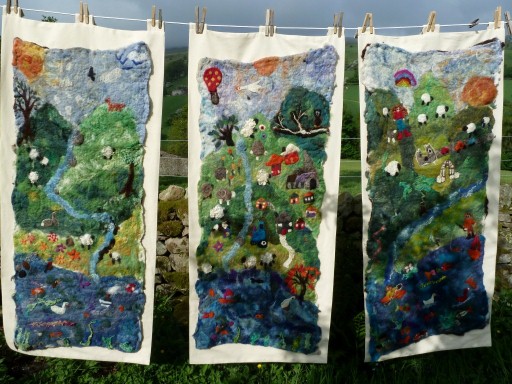 |
There is something very magical about laying out wool fibres and creating a piece of cloth, then laying out colours to create a work or art. When you have finished your design fold the under-layer of the cloth wrapper over your design and loosely stitch the sides together with long stitches. It will look like a small pillow. Put it in a sink or bowl; swirl over some washing-up liquid and cover with boiling hot water. Wear rubber gloves, and start squashing the fabric in the hot water. Work on both sides of the fabric in the pillow, making sure all the hot soapy water has really penetrated the wool. After working for ten minutes, gently squeeze the water out. Do not screw it into a ball as this would damage your design. Lay the work in a mat for rolling. Something with texture like a rush beach mat or bubble wrap works best. Place the felt, still in its cotton wrap, on the edge of the mat and roll it up tightly. Now roll it backwards and forwards applying pressure. Then unroll the mat and turn the felt around so a different edge is against the edge of the mat and roll it up again then roll it backwards and forwards applying pressure. Repeat this, changing the position of the felt each time, so you are felting by rolling it from all directions. Keep working until you see tiny wool fibres poking out of the cotton wrapping, indicating it is time to remove the fabric. Cut the stitches and gently remove the felt. Place back on the mat and continue rolling, changing the direction of the felt and turning the whole piece over from time to time. Keep rolling until you are happy with the smoothness and density of your felt fabric.
The longer you keep rolling the more the felt improves in quality. You need strength and elbow grease, but the magic of the evolving design will spur you on. When your felt is finished put it somewhere warm to dry. Students are filled with a sense of wonder and excitement as they create and shape a piece of art work from wool. The piece of art changes and evolves through the different stages of felt making, going from layers of loose fibres to strong decorative fabric.
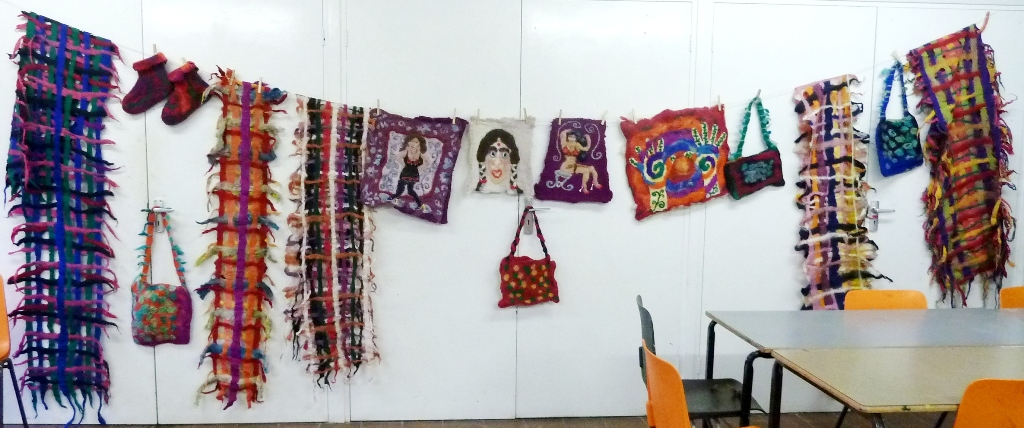 |
| Finished felt art pieces by Isobel Coney. ©2012 |